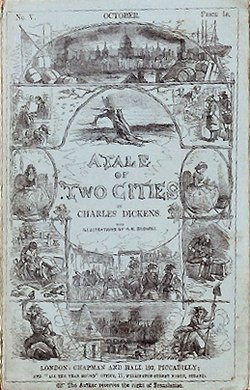 Cover of serial Vol. V, 1859 | |
| Author | Charles Dickens |
|---|---|
| Illustrator | Hablot Knight Browne (Phiz) |
| Cover artist | Hablot Knight Browne (Phiz) |
| Language | English |
| Genre | Historical novel |
| Set in | London and Paris, 1775–93 |
| Published | Weekly serial April – November 1859 Book 1859 [1] |
| Publisher | London: Chapman & Hall |
| Publication place | England |
| 823.8 | |
| LC Class | PR4571 .A1 |
| Preceded by | Little Dorrit |
| Followed by | Great Expectations |
| Text | A Tale of Two Cities at Wikisource |
A Tale of Two Cities is a historical novel published in 1859 by English author Charles Dickens, set in London and Paris before and during the French Revolution. The novel tells the story of the French Doctor Manette, his 18-year-long imprisonment in the Bastille in Paris, and his release to live in London with his daughter Lucie whom he had never met. The story is set against the conditions that led up to the French Revolution and the Reign of Terror.
Contents
- Synopsis
- Book the First: Recalled to Life
- Book the Second: The Golden Thread
- Book the Third: The Track of a Storm
- Characters
- Book the First
- Book the Second
- Book the Third
- Sources
- Publication history
- Analysis
- Opening lines 2
- Autobiographical material
- Contemporary criticisms
- Adaptations
- Films
- Radio
- Television
- Stage productions
- Stage musicals
- Opera
- Fiction
- Popular culture
- References
- Works cited
- Further reading
- External links
A Tale of Two Cities, Dickens's best-known work of historical fiction, is said to be one of the best selling novels of all time. [2] [3] [4] In 2003, the novel was ranked 63rd on the BBC's The Big Read poll. [5] The novel has been adapted for film, television, radio, and the stage, and has continued to influence popular culture.





